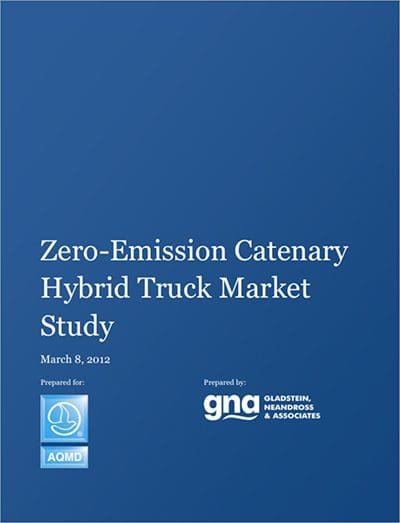
Zero-Emission Catenary Hybrid Truck Market Study
Published March 2012
Client: South Coast Air Quality Management District (AQMD)
Executive Summary
Despite major advances in air pollutant emissions performance, heavy-duty diesel trucks operating in dense urban areas continue to face pressure to achieve lower emission operation. In areas with historically poor air quality like the South Coast Air Basin, zero-emission requirements are being considered and may become standard. The South Coast Air Quality Management District (SCAQMD), California Air Resources Board (CARB), and Southern California Association of Governments (SCAG)—the agencies responsible for preparing the State Implementation Plan required under the federal Clean Air Act—have stated that to attain federal air quality standards the region will need to transition to broad use of zero and near zero-emission energy sources in cars trucks and other equipment. Zero-emission standards and technologies are also being proposed in the 2012 Regional Transportation Plan. The draft plan would affect the development of major freeways in Southern California—including the I-710 and CA-60—by adding zero-emission truck lanes to these key transportation corridors. The current near-dock rail yard development project known as the Southern California International Gateway (SCIG) has received significant public comment concerning air quality impacts from the project and may ultimately result in the inclusion of a requirement to use zero-emission trucks and other equipment. The planned expansion of the existing near-dock rail yard known as the Intermodal Container Transfer Facility (ICTF) is expected to face pressures similar to the SCIG to employ zero-emission technologies.
Rising diesel fuel prices and increasing fuel economy standards will also place additional pressures on heavy-duty truck manufacturers and their customers to consider alternatives to traditional diesel technologies. Truck manufacturers are actively pursuing drive train hybridization as a key technology pathway to simultaneously reduce fuel consumption and emissions. Based on developments in hybridization for a variety of heavy-duty markets, this report explores the potential market for a Zero-Emission Truck & Electric Catenary Highway (ZETECH) technology approach—a robust hybrid-electric truck platform with the ability to access overhead catenary power sources.
Catenary-powered hybrid trucks with internal combustion engines can simultaneously address emissions and fuel economy issues while providing operational flexibility at a similar or lower cost of ownership as other zero-emission technologies. Further, the path to catenary hybrid vehicles (CHV) is based on existing and well understood technologies that can be integrated today without the need for dramatic improvements in performance, cost, reliability, or durability.
A potential local market size of up to 46,000 trucks exists in the South Coast Air Basin, based on near-dock drayage trucks and trucks operating on the I-710 freeway. The I-710 is a major truck corridor scheduled to be expanded to include a four-lane roadway dedicated to truck traffic and incorporating zero-emission transportation infrastructure. Additional markets for the truck platform (with or without the catenary interface) include applications where low noise and/or lower emission operation is desirable, particularly in EU countries; and fleets affected by emissions regulations like current California fleet rules where a zero or ultralow emission truck would provide additional compliance flexibility. The total number of heavy-duty trucks subject to California fleet rules is estimated to exceed 500,000.
Compelling features of catenary hybrids include:
- Flexible truck platform that will allow for zero-emission operations in key regions of interest while still providing the standard operating range of local and regional haul goods movement trucks.
- Based on existing hybrid technologies and demonstrated system components, making the deployment of a catenary system for near-dock rail yards feasible in the 2016-2020 time frame.
- Unlimited zero-emission range when connected to a catenary system.
- Extensible system that can grow from near-dock facilities to the I-710 corridor and eventually comprise a zero emission electric container movement system sought by the ports.
- Ability to use natural gas in extended off-catenary operation, completely eliminating diesel emissions.
- Potential local market size of up to 46,000 trucks. Additional markets for the truck platform (with or without the catenary interface) include:
- Applications where low noise operation is desirable, particularly in EU countries.
- Fleets affected by emissions regulations like current California fleet rules where a zero or ultra-low emission truck would provide additional compliance flexibility.
- Similar or lower cost of ownership relative to other zero-emission technologies.
